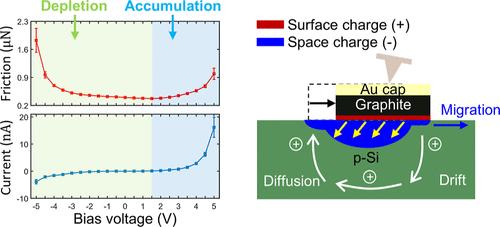Our official English website, www.x-mol.net, welcomes your
feedback! (Note: you will need to create a separate account there.)
Tuning Electronic Friction in Structural Superlubric Schottky Junctions
ACS Nano ( IF 15.8 ) Pub Date : 2024-11-12 , DOI: 10.1021/acsnano.4c11163 Xuanyu Huang, Zhaokuan Yu, Zipei Tan, Xiaojian Xiang, Yunxian Chen, Jinhui Nie, Zhiping Xu, Quanshui Zheng
ACS Nano ( IF 15.8 ) Pub Date : 2024-11-12 , DOI: 10.1021/acsnano.4c11163 Xuanyu Huang, Zhaokuan Yu, Zipei Tan, Xiaojian Xiang, Yunxian Chen, Jinhui Nie, Zhiping Xu, Quanshui Zheng

|
Friction at sliding interfaces, even in the atomistically smooth limit, can proceed through many energy dissipation channels, such as phononic and electronic excitation. These processes are often entangled and difficult to distinguish, eliminate, and control, especially in the presence of wear. Structural superlubricity (SSL) is a wear-free state with ultralow friction that closes most of the dissipation channels, except for electronic friction, which raises a critical concern of how to effectively eliminate and control such a channel. In this work, we construct a Schottky junction between a microscale graphite flake and a doped silicon substrate in the SSL state to address the issue and achieve wide-range (by 6×), continuous, and reversible electronic friction tuning by changing the bias voltage. No wear or oxidation at the sliding interfaces was observed, and the ultralow friction coefficient indicated that electronic friction dominated the friction tuning. The mechanism of electronic friction is elucidated by perturbative finite element analysis, which shows that migration of the space-charge region leads to drift and diffusion of charge carriers at Schottky junctions, resulting in energy dissipation.
中文翻译:

调整结构超润滑肖特基结中的电子摩擦
滑动界面处的摩擦,即使在原子平滑极限内,也可以通过许多能量耗散通道进行,例如声子和电子激励。这些过程通常是纠缠不清的,难以区分、消除和控制,尤其是在存在磨损的情况下。结构超润滑性 (SSL) 是一种具有超低摩擦力的无磨损状态,可以关闭除电子摩擦外的大部分耗散通道,这引发了如何有效消除和控制此类通道的关键问题。在这项工作中,我们在 SSL 状态下的微尺度石墨片和掺杂硅衬底之间构建了一个肖特基结,以解决该问题,并通过改变偏置电压实现宽范围(6×)、连续和可逆的电子摩擦调谐。在滑动界面处没有观察到磨损或氧化,超低的摩擦系数表明电子摩擦在摩擦调整中占主导地位。通过扰动有限元分析阐明了电子摩擦的机理,结果表明空间电荷区的迁移导致载流子在肖特基结处的漂移和扩散,从而导致能量耗散。
更新日期:2024-11-12
中文翻译:

调整结构超润滑肖特基结中的电子摩擦
滑动界面处的摩擦,即使在原子平滑极限内,也可以通过许多能量耗散通道进行,例如声子和电子激励。这些过程通常是纠缠不清的,难以区分、消除和控制,尤其是在存在磨损的情况下。结构超润滑性 (SSL) 是一种具有超低摩擦力的无磨损状态,可以关闭除电子摩擦外的大部分耗散通道,这引发了如何有效消除和控制此类通道的关键问题。在这项工作中,我们在 SSL 状态下的微尺度石墨片和掺杂硅衬底之间构建了一个肖特基结,以解决该问题,并通过改变偏置电压实现宽范围(6×)、连续和可逆的电子摩擦调谐。在滑动界面处没有观察到磨损或氧化,超低的摩擦系数表明电子摩擦在摩擦调整中占主导地位。通过扰动有限元分析阐明了电子摩擦的机理,结果表明空间电荷区的迁移导致载流子在肖特基结处的漂移和扩散,从而导致能量耗散。

































 京公网安备 11010802027423号
京公网安备 11010802027423号